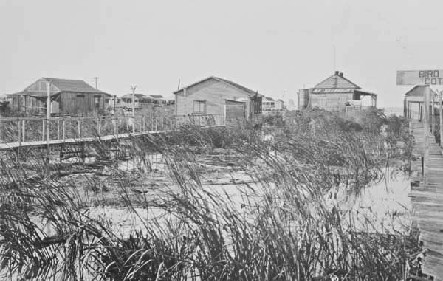
Voudoo Queen
The mention of “Voudoo Queen” will immediately bring to mind the formidable character of Marie Laveau, if it brings to mind anyone. Yet, Marie Laveau was not the only Voudoo Queen to preside over Voudoo practitioners in New Orleans. In 1869, news stories syndicated all over the country told about the naming of a new Voudoo Queen, a successor to Laveau. This woman was Malvina Latour.
Before going on much further, I feel compelled to say that the newspaper pieces that reported often on Voudoo culture between the 1860s and the 1910s were sensational and exaggerated. The aim of these news items appeared, to me, to be twofold: arouse excitement and curiosity in the public while at the same time demean black Americans by casting them as savages and animals. Some journalists were more respectful than others, but all the stories seem to share the perspective that Voudoo, and those that practice it, are some kind of mysterious other; something to be gawped at instead of understood. Knowing this, it is hard enough picking through the historical documentation to find truth. Historians of New Orleans have commented on how difficult it is to separate the truth from legend when studying the lives of people like Marie Laveau. With sensationalist news articles standing in as primary sources, we may simply have to accept that no story will be wholly substantiated.
Note: the spelling Voudoo was chosen for this post based on the spelling of the historical articles referenced for information.
Life of Malvina Latour
The first newspaper stories I could find that mention Malvina Latour show up around 1869 when she was said to succeed Marie Laveau as Queen of the Voudoos in New Orleans. An 1884 article by a reporter for the New Orleans Times-Democrat describes Malvina Latour as a handsome woman of mixed race around 48 years of age. This would mean Malvina Latour was born about 1836 and succeeded Marie Laveau when she was in her early 30s. Though the newspaper articles do not usually mention Marie Laveau’s daughter, Marie Laveau II, historians have pointed out that Laveau II was around and held quite a bit of power herself at this time, though she did not succeed her mother as Queen.
In 1886 Malvina Latour was again named as Laveau’s successor by another reporter, George Washington Cable, who had visited with Laveau before her death in 1881. Cable gave the conflicting information that the title of Voudoo Queen was held until death, and that only in 1881 did Malvina Latour take on the responsibilities. Other historians and legend makers have postulated that Malvina Latour herself was one of Marie Laveau’s daughters. Latour was sometimes referred to as Laveau or Laveau II. Confusing the three women fed Marie Laveau’s legend by lengthening her time in power to an unbelievable spans.
Yet, Malvina Latour peeks through history. Often described, young and old, as sporting a blue calico dress with white polka-dots, Latour would be Queen of the Voudoos, leading St. John’s Eve celebrations on the banks of Lake Ponchartrain, for around two decades. She was regarded as powerful as Laveau, and had performed feats that equaled those of her predecessor, though reportedly she did not add anything new to the practice while Voudoo Queen. According to many, Latour’s primary goal was to remove Catholicism and Catholic practices from Voudoo. She was unsuccessful at this and also at holding the Voudoo community together in the face of many different bids for power. Under Latour, Voudoo in New Orleans split into several factions, never to be reunited. Latour’s eventual abdication and later life are a mystery.

Truth, Legend, & Mystery
Carolyn Morrow Long, author of A New Orleans Voudou Priestess: The Legend and Reality of Marie Laveau, postulates that the New Orleans Times-Democrat reporter in 1884 may have invented Malvina Latour. Long bases her hypothesis on not being able to find Latour in any church, city or census records, and indicates that the invention of Latour was “indicative of how such sensational accounts came to be regarded as historical and factual.” Yet, the 1886 piece by George Washington Cable that also reported Latour as the successor to Laveau, was apparently unconnected with the previous journalist, revolving around an interview and visit with the aging Laveau. This, to me, serves more as corroboration of Latour’s existence since Cable’s article did not rehash the same stories and visuals of previous articles the way that most newspaper articles of the time seemed to do. I also have spent several hours searching for links in my family tree during the middle and late 1800s that were not recorded by census, church, or city records, so it does not seem strange to me that Latour is not mentioned in these documents.
Though I cannot immediately accept that Latour was a fiction, Long was making an excellent point that the legend of the Voudoo Queen has grown beyond the truth. This becomes evident when faced with obviously conflicting information like the interview with Dr. J. B. Bass of New York, in the Chicago Daily Tribune of 1881. Dr. Bass was a known Voudoo practitioner and had met Laveau when he was a teenager. He asserted that there was no such office as Queen within the order; that Laveau was a mother in the order and had respect, but held no official office. Could this be chalked up to the unique and independent way New Orleans Voudoo has evolved over time, where in the city Laveau and Latour were Queens, but in the worldwide Voudoo community, they held no such office? A later article recounting St. John’s Eve celebrations in 1890 includes recounted testimony from Marie Laveau’s daughter, perhaps Laveau II, refuting that Laveau was ever connected with Voudoo at all. Who then did Latour succeed?
As an illustration of how legend can take over our popular history Malvina Latour has since been linked to the ghost story of a violet eyed zombie girl whose prison was broken by hurricane Katrina and now roams about New Orleans. Though the best guesses at Latour’s possible birth and death dates are so far away from overlapping with her supposed role in the story, the story serves as an interesting example of how our own sensationalism can replace our history.
References
- “The Dead Voudoo Queen.” Chicago daily tribune. [volume] (Chicago, Ill.), 16 July 1881. Chronicling America: Historic American Newspapers. Lib. of Congress. <https://chroniclingamerica.loc.gov/lccn/sn84031492/1881-07-16/ed-1/seq-11/>
- Declouet, Fred (1999) Scandalous New Orleans: An Encyclopedia of Crime, Prostitution, Corruption, Loose Ladies, Gamblers, and Crooked Politicians. AuthorHouse. https://books.google.com/books?id=bkLLwNLO02kC&lpg=PA17&ots=9rK1gKXhgv&dq=%22MALVINA%20LATOUR%22&pg=PA17#v=onepage&q=%22MALVINA%20LATOUR%22&f=false
- “Election of a New Queen by the Negro Voudou Worshippers.” The Charleston daily news. [volume] (Charleston, S.C.), 17 June 1869. Chronicling America: Historic American Newspapers. Lib. of Congress. https://chroniclingamerica.loc.gov/lccn/sn84026994/1869-06-17/ed-2/seq-1/
- “A Famous Voodoo Queen.” Daily Yellowstone journal. [volume] (Miles City, Mont.), 06 May 1886. Chronicling America: Historic American Newspapers. Lib. of Congress. <https://chroniclingamerica.loc.gov/lccn/sn86075021/1886-05-06/ed-1/seq-4/>
- Gordon, Michelle Y. (2012) “Midnight Scenes and Orgies”: Public Narratives of Voodoo in New Orleans and Nineteenth-Century Discourses of White Supremacy, American Quarterly; College Park Vol. 64, Iss. 4, (Dec 2012): 767-786,914.
- ?Hearns? (1884). Voudou dance; revival on the lake shore of the voudou mysteries: Description of the celebration of the Eve of St. John by creole voodoo queen Malvina Latour and her attendants in New Orleans Louisiana. . Times Democrat (New Orleans. LA. Louisiana Digital Library (Louisana Works Progress Administration. Louisiana Digital Library. https://louisianadigitallibrary.org/islandora/object/state-lwp%3A8520
- Mickey of Miami (nd) Violette with Eyes to Die For. Haunted New Orleans Tours. http://www.hauntedneworleanstours.com/zombie/violette/
- Voudooism; a chapter of old New Orleans history. (1890) Daily Picayune. United States. Works Progress Administration of Louisiana. Louisiana Digital Library (https://louisianadigitallibrary.org/islandora/object/state-lwp:10105)
- “Voodoo Queen Marie” (nd) The National Night Stick. http://national.night-stick.com/home/index/70361-voodoo-queen-marie
